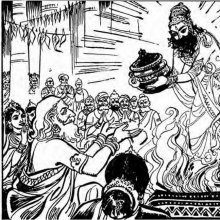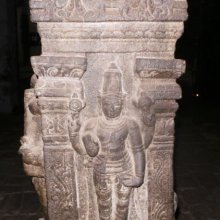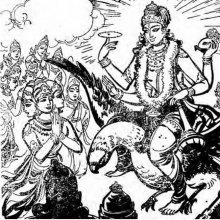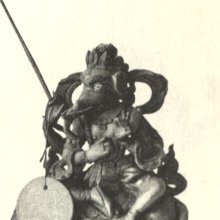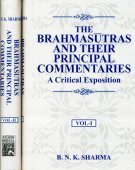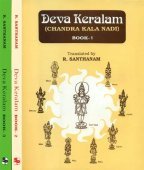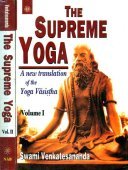Teva, Ṭēva, Ṭeva, Tēvā, Ḍhevā: 6 definitions
Introduction:
Teva means something in Marathi, Hindi, biology, Tamil. If you want to know the exact meaning, history, etymology or English translation of this term then check out the descriptions on this page. Add your comment or reference to a book if you want to contribute to this summary article.
Images (photo gallery)
(+56 more images available)
Biology (plants and animals)
Source: Google Books: CRC World Dictionary (Regional names)1) Teva in Gabon is the name of a plant defined with Desbordesia glaucescens in various botanical sources. This page contains potential references in Ayurveda, modern medicine, and other folk traditions or local practices It has the synonym Irvingia oblonga A. Chev. (among others).
2) Teva in India is also identified with Sansevieria roxburghiana It has the synonym Cordyline roxburghiana Merr. (etc.).
Example references for further research on medicinal uses or toxicity (see latin names for full list):
· Revisio Generum Plantarum (1891)
· Botanische Jahrbücher für Systematik, Pflanzengeschichte und Pflanzengeographie (1902)
· Systema Vegetabilium ed. 15 (1829)
· Species Plantarum, ed. 4 (1799)
· Annales des Sciences Naturelles (Paris) (1905)
· Pl. Coromandel (1805)
If you are looking for specific details regarding Teva, for example chemical composition, pregnancy safety, health benefits, extract dosage, side effects, diet and recipes, have a look at these references.

This sections includes definitions from the five kingdoms of living things: Animals, Plants, Fungi, Protists and Monera. It will include both the official binomial nomenclature (scientific names usually in Latin) as well as regional spellings and variants.
Languages of India and abroad
Marathi-English dictionary
Source: DDSA: The Molesworth Marathi and English Dictionaryṭēva (टेव).—m P A trick, a vitious habit or way: also a hobby or fancy taken up.
--- OR ---
ṭēva (टेव).—m pl R The arts and tricks o coquettes, flirts, and beaus,--adorning or displaying the person, exhibiting gestures &c. v kara.
--- OR ---
ṭēvā (टेवा).—m R A little hole (as dug or arising in the ground or a wall); a hollow or cavity on a surface gen. 2 Pricking and probing of a puncture.
--- OR ---
tēva (तेव).—m The exudation from sugar, wax &c.: also the oozing away or liquefaction of such substances; the sweat or the sweating.
Source: DDSA: The Aryabhusan school dictionary, Marathi-Englishṭēva (टेव).—m A trick, a vitious habit or way: also a hobby or fancy taken up.
--- OR ---
ṭēva (टेव).—m pl The arts and tricks of coquettes, flirts, and beaus.
Marathi is an Indo-European language having over 70 million native speakers people in (predominantly) Maharashtra India. Marathi, like many other Indo-Aryan languages, evolved from early forms of Prakrit, which itself is a subset of Sanskrit, one of the most ancient languages of the world.
Hindi dictionary
Source: DDSA: A practical Hindi-English dictionaryṬeva (टेव) [Also spelled tev]:—(nf) habit, wont, settled tendency; —[paḍanā] to fall into the habit (of), to acquire the habit of.
...
Kannada-English dictionary
Source: Alar: Kannada-English corpusTēva (ತೇವ):—[noun] a slight wetness; moisture; damp.
Kannada is a Dravidian language (as opposed to the Indo-European language family) mainly spoken in the southwestern region of India.
Tamil dictionary
Source: DDSA: University of Madras: Tamil LexiconTēvā (தேவா) noun < Urdu devī. See தேனா. [thena.] (C. G.)
Tamil is an ancient language of India from the Dravidian family spoken by roughly 250 million people mainly in southern India and Sri Lanka.
See also (Relevant definitions)
Starts with (+162): Teva taram, Teva-catciay, Teva-katieluttu, Teva-meraiay, Tevacamukam, Tevacanku, Tevacapai, Tevacattuvam, Tevaccantam, Tevacenapati, Tevacenapaticam, Tevacenapaticar, Tevacikiccai, Tevacintanai, Tevaciriyan, Tevacivan, Tevacutti, Tevada, Tevadaram, Tevade.
Ends with: Avalupyateva, Bhidyateva, Chidyanteva, Dalyateva, Katteva, Kuteva, Nishpidyateva, Nittiyateva, Nteva, Oteva, Pacyateva, Samharshiteva, Utpatayateva, Visteva.
Full-text (+4893): Deva, Devaraja, Devakula, Devaratha, Devamaya, Devabhuya, Devadroni, Taratha, Devanama, Devasva, Mahadeva, Devalinga, Devaprashna, Devadaru, Devayatana, Devavara, Devashilpin, Devanikaya, Devavaktra, Devapati.
Relevant text
Search found 337 books and stories containing Teva, Ṭēva, Ṭeva, Ṭēvā, Ṭevā, Tēva, Tēvā, Theva, Thevaa, Thaevaa, Deva, Dheva, Ḍhevā; (plurals include: Tevas, Ṭēvas, Ṭevas, Ṭēvās, Ṭevās, Tēvas, Tēvās, Thevas, Thevaas, Thaevaas, Devas, Dhevas, Ḍhevās). You can also click to the full overview containing English textual excerpts. Below are direct links for the most relevant articles:
Tiruvaymoli (Thiruvaimozhi): English translation (by S. Satyamurthi Ayyangar)
Pasuram 3.6.2 < [Section 6 - Sixth Tiruvaymoli (Ceyya Tamaraik Kannan Ay)]
Pasuram 5.3.9 < [Section 3 - Third Tiruvaymoli (Macu aru Coti)]
Pasuram 9.2.8 < [Section 2 - Second Tiruvaymoli (Pantai nalale)]
The Great Chronicle of Buddhas (by Ven. Mingun Sayadaw)
The Story of Deva Gopaka < [Chapter 39 - How the Āṭānāṭiya Paritta came to be Taught]
Part 5 - Biographies of Ankura Deva and Indaka Deva < [Chapter 24 - The Buddha’s Sixth Vassa at Mount Makula]
Part 2 - The Buddha’s Discourse to Sakka (Sakka Pañha Sutta) < [Chapter 39 - How the Āṭānāṭiya Paritta came to be Taught]
The Catusacca Dipani (by Mahathera Ledi Sayadaw)
Part II - The Burden of Dukkha in the Deva World < [The Exposition Of Four Characteristics]
How Beings Have To Wander In The Round Of Rebirths < [Part I - The Manual Of The Four Noble Truths]
A Multitude Of Dukkha For Cultivators < [Part I - The Manual Of The Four Noble Truths]
Puranic encyclopaedia (by Vettam Mani)
Abhidhamma in Daily Life (by Ashin Janakabhivamsa) (by Ashin Janakabhivamsa)
Part 3 - Abodes Of Devas < [Chapter 11 - Planes Of Existence]
Part 3 - The four type of individuals (puggala) < [Chapter 9 - Patisandhi (the nature of rebirth)]
Part 1 - The Four Types Of Patisandhi < [Chapter 9 - Patisandhi (the nature of rebirth)]
The Mahavastu (great story) (by J. J. Jones)
Related products
(+5 more products available)

